Posts By kateb
Waste Land: A Climate Anxiety Haunted House

Waste Land: A Climate Anxiety Haunted House is a public art project curated by myself, Kate Brooks-Heinimann, and Kay Gallivan . We turned a pre-demolition house into a pop-up haunted house art exhibition themed around climate anxiety. The project was organized by students in the University of Victoria’s Teacher Education Program in collaboration with students at Esquimalt High School. It was open to the public and involved many artists from the Victoria community.
The purpose of Waste Land was, and still is, to raise awareness about the climate crisis in an accessible, creative, and artistic way. Participating artists were encouraged to use reclaimed materials for their work and have it relate to the theme of climate change and climate anxiety.
Social Media Links
Website https://www.wastelandclimateanxiety.com/
Facebook https://www.facebook.com/wastelandclimateanxiety/
Instagram https://www.instagram.com/wastelandclimateanxiety/
Virtual Reality!
What a crazy thing!
I had tried virtual reality (VR) once before at Pacific School of Innovation and Inquiry. The process involved putting on a pair of goggles and then proceeding to convince myself that the plank I was standing on was not actually on top of a sky scraper and if I were to fall I wouldn’t actually fall to my death. Even though I knew that to be true, it still felt terrifying. The only way I could walk the plank was by going down onto all fours and rolling off. Yes, my classmates laughed. My heart was 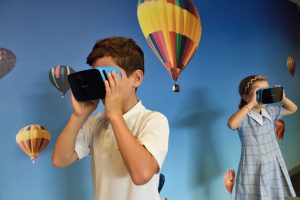 racing and my palms were sweaty even after finishing the challenge.
racing and my palms were sweaty even after finishing the challenge.
UVic Experience
My experience at UVic last week was not as intense. It was lighter introduction to the VR world. However, I did become nauseous and had to put the device down earlier than I wanted to. Apparently women are more likely than men to feel motion sickness in VR. Here’s a related article that argues motion sickness in women to be caused by posture –> https://www.newscientist.com/article/2115648-posture-could-explain-why-women-get-more-vr-sickness-than-men/ .
At UVic, I flew around Google maps, exploring European castles and tropical beaches, and occasionally shooting off into outer space. It was pretty neat but unfortunately (fortunately?) lacked the “thrill” of my first experience. This time around my VR experience was more about enjoying the scenery and learning about different geographic locations, rather than pushing my physical and mental body to the limit.

VR in Education
I could see VR beingused as a educational tool. However, I did learn that anyone under the age of 13 years old should not use VR, and those between the ages of 13-15 can use it but should do so sparingly. I could see VR being used in an art room to help render 3D models before they’re actually brought to life, and could also provide a space for students who want to work B I G but don’t have the capacity to due to lack of funds, time, etc. These students could build their work in VR and then show the class what their work would look like if it were in real life!
Photo by Matthew T Rader on Unsplash
Learning Code

Today we learned a bit about coding by Rich McCue (website: http://richmccue.com/)! There’s a few different sites that help first-timers learn the basics of coding. Some include:
Scratch – https://scratch.mit.edu/
Grasshopper – https://grasshopper.codes/
Hour of Code – https://hourofcode.com/ca
Code BC – http://codebc.ca/
My Focus
I explored Scratch, which is known to be a more visual and intuitive way to begin learning code. While easy to navigate, being a total beginner with code, I did find there was a learning curve, and I think in order to advance in this program I would need to either spend time watching instructional videos or consult Rich or Val. Here’s a photo of what I did today!
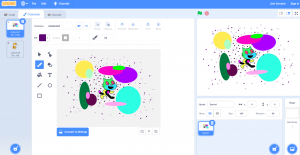
I developed a character, and had a lot of fun doing it. However, I didn’t get around to making the character move or speak. I would need some more help with this.
Overall
I could see this being a great introduction for students wanting to learn more about code, and for those who show interest in animation as there is some cross-over.
Learner Sharing Sessions
 Today’s Class
Today’s Class
Today in Ed Tech we learned how to utilize technology to facilitate meetings if one or more people were not able to be in the room. This also extends beyond the university setting and can be applied to high schools.

Hypothetical Situation
As a class, we discussed the benefits of having access to this technology in a high school. Most high schools do have this capability, which is of huge benefit to students who may not feel comfortable coming to class for whatever reason. Say a student is sick, or has an injury and is unable to get to school on that day, they could access the classroom via camera technology. The same goes for an educator. If the educator is unable to attend the class, they could teach the class this way. This technology allows for a more accessible educational environment. It also provides an alternative option for students who may have long commutes to school and would prefer to only attend a couple times a week to mitigate the travel time.
Overall
I would use this in my classroom. Its a great way to have students and educators engaged and made to feel welcome in the classroom setting if they couldn’t be otherwise.
Minecraft in the Classroom
Today we had a brief introduction to Minecraft taught to us by Colquitz Middle School teacher Heidi James and her students. They did a great job! They walked us through how to join a Minecraft game, and then we had half the class to play the game. I did a lot of exploring of the landscape, collected fruits, fought a zombie, steered a boat in water, and climbed up really tall structures my classmates had built. While it was entertaining for some and I can see how some people would love it, I don’t think it’s for me.
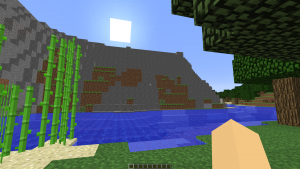 Here is a screenshot of the Minecraft world I was in. Moments earlier there was a giant squid in the water! Apparently, as a Minecraft character, you can get ink from the squid. I tried, but no luck 🙁
Here is a screenshot of the Minecraft world I was in. Moments earlier there was a giant squid in the water! Apparently, as a Minecraft character, you can get ink from the squid. I tried, but no luck 🙁
Uses of Minecraft
While you can’t get too specific with Minecraft features, it is possible to use it to learn general information in a subject. For example, if you were teaching a gardening class you could use Minecraft to map out the structure of the garden, and what vegetables would go where. However, you would be limited to a certain few vegetables, so there may be veggies that you would want to include in your actual garden that couldn’t be put into the Minecraft garden.
I also learned that the Colquitz class had used Minecraft as a way to learn about ancient civilizations. How cool! In this way, I could see MInecraft being very useful in the classroom as it gives students an interactive way to learn about and discover a past civilization.
Things I Noticed While Playing Minecraft
– most people were really engaged with the game
– my peers who had previous experience with Minecraft were helping those who didn’t
– there was lots of laughter and excitement in the room; we were having fun!
– I felt a little nauseous after playing for about 25 minutes straight 🙁
Interesting Sources to Check Out
– https://www.educationworld.com/a_tech/benefits-minecraft-classroom-students.shtml
– https://www.minecraft.net/en-us/
– a video of educators speaking about the uses of Minecraft in education
Remix Manifesto Thoughts
What is Remix Manifesto?
A documentary exploring copyright and content creation, focusing on the electronic music artist, Girl Talk, who’s music is a unique blend of old and new music mash ups.
Here’s a trailer:
Here’s a link to the full movie: http://https://www.nfb.ca/film/rip_a_remix_manifesto/
The film had me pondering…
The greed that comes with fame, and how even the slightest sampling of an original song can be cause for a law suit and copyright battles. I also found it interesting to compare Girl Talk’s take on electronic music production and sampling to other artists who work more “underground” in the electronic music world. Sampling happens all the time, and more often than not most producers are totally fine with other artists incorporating their work into a mix, or a DJ set. Maybe this is because in smaller communities there is a general understanding that artists support other artists; they’re all in it together. Sampling another artist’s track in your work isn’t necessarily seen as “stealing” or something that must be paid for in order to do. It’s more about sharing.
In Girl Talk’s case, he’s working with some pretty big hits. I guess that’s where the problem lies. The sheer popularity of the songs he’s mixing and the audience to which he plays his music changes the entire concept. It is no longer seen as “sharing”, but rather, “stealing”. This makes me think about something the artist Emily Carr once said, “cities make people sick”. While I take that with a grain of salt, I do understand what she means and how this could be used an an analogy to describe what happens when music goes “mainstream”.
 When Music Becomes Popular
When Music Becomes Popular
When music goes mainstream and sways away from the small communities it used to be part of it loses its ability to remain a shared resource. It now sits on a pedestal instead of being amongst its original community. While there’s benefits to this, such as financial gain and popularity, it also has its down side. It moves itself outside of the community which originally supported its sharing and connection. There are rules on the pedestal. Sharing isn’t encouraged; and the audience has changed, too.
Final Thoughts
I wonder what would happen if Girl Talk incorporated underground electronic music into his work? Maybe his crowd would change. Maybe he’d have to worry less about copyright. Would underground producers allow him to use their work for free?
Multimodal Case Study
Focus Question: Who Are My 21st Century Multiliterate Students?
My group, which I shared with Gurkirat, is a group of 4 students from Esquimalt High School. Jet, Harbour, Angelina, and Ray, first introduced themselves as students who attended high school together but were not necessarily friends with each other. However, they were able to bond over their shared interest in film and theatre. This allowed them to develop a film project to address their concern relating to climate change and anxiety. Throughout the process of constructing their video for Waste Land: A Climate Anxiety Haunted House, I was able to see connections form between each student, despite Angelina and Ray being away for almost half of the Esquimalt visits. Even though they were absent for 2 – 3 classes, I still feel as though they contributed to the project and that we were able to connect with each other.

The Waste Land: A Climate Anxiety Haunted House in progress. Students were really excited to see the house at this point!
Day 1
On the first day, Gurkirat and I conducted a couple of ice breaking activities. The first being general chit chat about what subjects they enjoy the most in school and why. We also asked them if they could go anywhere in the world, where would they go? The answers were varied, and I was surprised to see how shy some of the students were. Their shyness changed to engagement and confidence by the end. The first day together helped to establish a bond between myself and the students, which was more challenging than I had anticipated. I expected the students to be excited, energetic and motivated about this fantastic new opportunity for them to learn alongside pre service teachers. While they ended up feeling that way by the end of our visits, their enthusiasm did not shine at the beginning, and I left feeling slightly uninspired. However, I was optimistic that the project we had developed would be attainable by the end of the month and that it would be something the students would enjoy working on together. Gurkirat and I left the class having explained clearly what each student should do for next week, and were pleased that we managed to create the framework for an entire project in such a short timeframe.
Project Accomplishments
– established project
– delegated tasks for each student to have completed for next week
Day 2
I was not prepared to hear the work we had asked them to do was not finished, let alone started. I felt nervous, flustered, and annoyed. What are we going to do? I came prepared, ready to move onto the next step, but now we faced a set back. I took a pause, and realized that I have to roll with what is presented to me, and continue moving forward to achieve our end goal. Keeping in mind that we aren’t running for an Oscar helped, too. Another set back presented itself; the students weren’t excited about the original idea of creating a theatre skit, and wanted to do something else. So, in order to make this project be something they’re excited about, we had to figure out what really excites them. We took the rest of the class to brainstorm and get to know each other a bit better, which helped develop a sense of camaraderie and trust between all of us. Gurkirat and I really persisted in getting to know the students, and by the end we all had a better understanding of who we were working with, what we enjoyed doing, and which direction we wanted the project to go. We decided that next class we would devise a sold plan to create our project. I left that class feeling much more connected to my group. Although we didn’t accomplish much on our project, we bonded and developed trust.
Project Accomplishments
– bonded; really got to know each other’s interests, especially as they pertain to the project
– developed trust
Day 3
Having left last class feeling much better than the first, I was confident we could manage the day ahead. As a group (minus Ray), we quickly developed a plan for our day. We also decided to have all the required work for completing the project done only within class time. There would be no more homework or outside of class activities given. Once we had a plan of action to make a film relating to climate change, we began. It was a full day. We had little time to sit down and relax, but I loved it and the students seemed to as well. Today was the first day where I really noticed them working together enthusiastically. For the first 20 minutes we developed an attainable plan of action; what we had to do today to be ready for the next class. The first series of tasks involved making a costume, seeking out necessary materials, and assigning roles to each group member. We completed all of our necessary tasks by the end of day, and even got some filming in! I again left the class feeling joyful at all we had accomplished in such a short time.
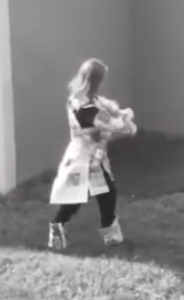
Harbour in his “Trashman” costume – bottles, cans, and plastic garbage is attached to his costume as well!
Project Accomplishments
– continued bonding, this time while working
– plan of action made
– made costume
– sought out necessary materials for film
– assigned roles to each group member
– we had a lot of fun!
Day 4
This day we really began working as a team, although Angelina and Ray were not present. Connections between each group member seemed to be a lot more natural and confident. Harbour and Jet both did a wonderful job at sticking to day’s plan, and we able to finish everything necessary to stay on track and get the project completed by its due date. They filmed almost the whole movie today, and had their costumes from the previous week ready to go. We did have to spend some time gathering some extra supplies, but that only took a few minutes so didn’t act as a major set back. Everyone in the group did a good job of contributing to that task. I was so proud of them for how hard they tried, and how they really took it upon themselves to make the project their own. They also seemed a lot more comfortable around me, and asking questions about the project and even about myself seemed more natural. This was the first day that I realized I would actually miss these visits with my group and a bond had been formed and we were starting to get along well.
Project Accomplishments
– filmed a majority of the movie
– began to feel way more natural and comfortable around each other
Day 5
The group was again just Harbour, Jet, myself, and Gurkirat. Perhaps it was the small group dynamic that made it seems easier or more comfortable, but today felt like a breeze. I really couldn’t believe how much easier it was to work with the group. We seemed to understand where each other were coming from a lot more clearly, and were getting things done with lightening speed and still learning and connecting in the process. The filming finished today, and we began editing a little bit in iMovie. Harbour was able to share with us his knowledge of iMovie. He really lit up when presented with the opportunity to teach us about the program’s many functions. I could tell this was an area of interest to him, and we all connected through his teaching of the program to us. We were each able to provide feedback about what we thought might make the film stronger; from special effects, to music choice, and playing with scenes and adding photographs into the film as a “subliminal message” sort of effect. This was one of my favourite classes as we bonded a lot over creating the movie, and I also got to see how confident Harbour is when he’s sharing something he has knowledge in.
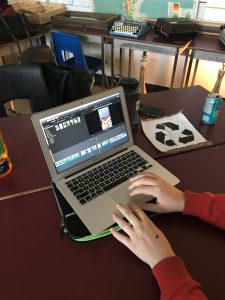
Harbour working on the Trashman vs Recycleman film
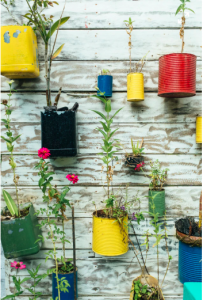
One of the “subliminal messages” about recycling selectively placed into the film
Project Accomplishments
– finished filming!
– began editing in iMovie
– continued bonding and developed a stronger group dynamic
Day 6
We finished editing, discussed where to place the film on the gallery walk day, and made a plan of what had to be done in order to have it all ready for the gallery walk. The first thing we finished was adding the final touches to the film in iMovie. Again, Harbour was elated to show us how to use it and we all bonded over learning about the program and sharing our ideas of what we think could be added to the movie. This portion of my Esquimalt visits really struck me. It showed the importance of giving students autonomy and allowing them to teach the teacher. I learned a lot from watching my group interact with each other; it showed me some really valuable ways to connect to students and also what they find engaging. I realized that they just want to be treated like humans, not necessarily “students”. They also really appreciate authenticity and humour (when used well), and feeling as though they are respected, and capable of making their own decisions and working independently. While these may seem obvious, I have seen and experienced feeling like a “child” in high school classes, mostly in front of power tripping teachers. It’s an awful feeling, and I never want students to feel that way around me or in my classes. We are equal, and while I am the one teaching, they also have so much to teach me.
Project Accomplishments
– secured a projector for the gallery walk
– secured a space to play our video
– finished editing
– uploaded video to YouTube
– further bonding
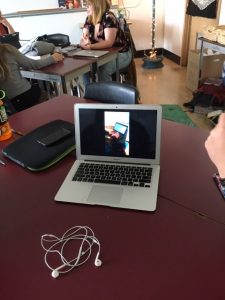
A photo of Trashman vs Recycleman being played for one of the first times!
Day 7
Gallery walk day! I couldn’t believe we were here already. Where did the time go? I felt excited. We were totally prepared and ready to set up, however, we did experience a minor set back. The spot we had originally settled on to show our film was now off limits. We had to find another spot, which ended up being easy enough, but it did take up 10 minutes of our time. We settled in a spot across from the auto shop. It was louder and a little hidden, so not ideal, but we rolled with the punches and did our best with what we had. There were at least 15 students that stopped by to watch the video. This, seemingly, gave our group members a confidence boost in that they were able to say they not only acted in the video but created it all in iMovie as well, and within a short time frame. I was so proud of them! Before going to view the other projects, we had a little debrief about how the project went; what the their final thoughts were on the movie, and if there was anything they wish they had done differently. We also talked a little bit about climate change and anxiety around that. For the most part, the conversations this time were a lot more in depth and honest. It didn’t seem surface level anymore. It made me really excited to know that they trusted me enough to let me see a part of their true self, not just them in a student role. Ray, who hadn’t been in class since the second session, was really impressed with how the movie turned out, and also created a conversation with me by asking how I was doing. We chatted about school and the business of being a teacher in training. This was, to me, a pretty big break through as I think Ray is maybe a little shyer than some of the other students, and also had missed out on a large chunk of the sessions together.
Things That Stuck
One our last day together, I asked the group what classes they enjoy the most, and why? The common thread amongst their responses is that instructors who are willing to do things differently or conduct lessons with some sort of creativity and outside the box thinking, is what really grabs them and makes them want to learn. I also discovered through this conversation that most students are not disinterested, but rather very tired. They often have a lot on their plate, and when they get home at night are just wanting to sleep or disengage. Adding the stressor of extra homework when its not really necessary isn’t something I want to do in my classes when I become a teacher. I’ve learned, by being a student myself, and by speaking with my group, that its best to keep the learning within the classroom; with the option of bringing it home if a student chooses. A tired student isn’t an engaged one, and having a teacher be there to facilitate makes for a supportive learning environment.
One reading in particular, the First Peoples Principles of Learning, really helped inform my interactions with the students and the approach I took towards facilitating the project. During set backs, for example the second day, I kept in mind the First Peoples Principle of Learning that “learning involves patience and time”. I realized that the process is part of the learning, and if in that process something isn’t working I need to make a change. The change I made in that case was to have all necessary work done during class; no homework would be given. Another Principle that guided me during my time with the group was “learning is holistic, reflexive, reflective, experiential and relational (focused on connectedness, on reciprocal relationships, and a sense of place). I realized early on that this principle would be key to forming any sort of working relationship with the students; we needed to feel connected to each other. In order to achieve this we took the necessary time to bond and form trust. Much of that was done on day 2, when it was clear to me we needed connection before we could go any further with the project and have it be an enjoyable and natural process. On the final day, I made use of the Principle “learning requires exploration of one’s identity”, and asked some final debriefing questions to the group. When we began discussing climate change and their views towards it, a natural discussion emerged between the students and they began to gently explore their own identities.
While the final goodbye was far less memorable than I had expected it to be (in my head they would have wanted to hug me and say how much fun they had – HA! I am too used to teaching children!), I do have a feeling that our time together was more than a little inspiring to them. Throughout it all I just hope they enjoyed the process, and gained something of value from it; whether it be feeling more connected to their peers, understanding their views on climate change a little more, or gaining some useful technical skills in iMovie and other computer programs. I really did enjoy my time spent with the group, and I hope they did, too!
The Final Film: Trashman vs Recycleman
Plant Snap Review

For the Tech Inquiry project I am, along with my group, researching plant identification apps. The first one I have tried is called Plant Snap. It’s free and pretty reliable. Here’s a bit more about it…
What can I do with PlantSnap?
🌿 take photos of unknown plants, flowers, cacti, and succulents, and discover their names
🌿 upload a plant photo from my photos to use in the app
🌿 put “snaps” into “my collection” folder on the app
🌿 search within a database of 585,000 plants
🌿 search for gardens, and people/accounts
🌿 scroll through a “feed” page that has recently posted PlantSnaps by the app’s users
🌿 add “friends” by following other PlantSnap users
Pretty sweet! What don’t I like? Well…
🍂 limited to taking 10 snaps a day as a non-premium user
🍂 have to view advertisements as a non-premium user
🍂 my feed is filled with people I do not know and I can’t stop that
🍂 there’s a lot of extra stuff I don’t need; like the “feed”, explore function (allows me to view plants around the world), and I also keep getting posts asking if I am learning a new language
🍂 sometimes the PlantSnap calculator is incorrect; it mistakes the plant I’ve uploaded for another plant, and I have to do a bit of digging to see if each plant I have photographed really is what the app tells me it is.
🍂 when I post a photo to my collection it automatically attaches my photo to the plant’s page. For example, the photos below are mine, and were added to the plants page without my permission. I don’t actually mind this, but someone else may be bothered
Some of my own snaps!
 Loved learning this berry is edible! I ate one the other day thanks to this app!
Loved learning this berry is edible! I ate one the other day thanks to this app!
 This was a test to see if the app could identify the common snowberry. It did!
This was a test to see if the app could identify the common snowberry. It did!
Final Thoughts
I do like this app. Its pretty user friendly, despite the ads, and I don’t have to engage with the explore function and feed if I choose not to. These functions might also be very useful to another person unlike myself. I also bet that if I purchased the premium (which is $12.00 for a lifetime), many of the minor annoyances would disappear and be replaced with some perks. For me,10 snaps a day is definitely manageable, and I’m not using the app to connect with other users but merely as a way to figure out which plant I have discovered!
If you’re curious about trying PlantSnap, I’d say go for it. Its free and does the job if you’re just looking to learn the name and some brief information about a plant you’ve stumbled across.
Website Link
https://www.plantsnap.com/
Ed Camp Reflection
In today’s EDCI 336 class we had the chance to do a mock version of an Ed Camp. Ed Camp is a teacher-created discussion session, formed by the interests of the people in the room. In Ed Camp, there everyone is one the same level and there is no main presenter, and no slide shows. These group discussions are meant to be learner driven by those in the room who share their experience and expertise on the discussed topics.
Here’s a link to the Ed Camp website —> https://www.edcamp.org/
Our Mock Ed Camp
Our group discussed who our favourite teacher was in high school and why. There was a common thread amongst our group; that our favourite instructors were those who…
1) did things differently/weren’t afraid to break out of the traditional mold of teaching
2) were kind and genuinely believed and supported our growth and success as both a student and an individual
Personal Thoughts
These two attributes were things that brought us closer to ourselves and our teachers, which in turn created a more inclusive and diverse learning environment. For myself, school was a struggle. I didn’t enjoy the day to day routine, long days, and never ending homework load. Added on top of that was, for the most part, boring class time caused by teachers who didn’t include creativity or unconventionality in their classrooms. Being a creative and slightly unconventional person, I felt unsupported and crushed by my high school environment. The teachers that stood out to me were those who brought elements of theatre in their classrooms and weren’t afraid to think outside the box and encourage their students to do so, too. This made me feel like I was welcome somewhere; that my different way of thinking and being was accepted by at least someone in the school environment. It made me feel less alone and awkward, especially when I saw how well received the teacher’s teaching was taken by other classmates. It gave me the self esteem I needed to fell comfortable in my own skin.
Climate Strike Week 2 (The BIG one!)

Global Climate Strike: 20,000 Strong!
On Friday, September 27th, I had the opportunity to attend the main Global Climate Strike event. I attended, with an estimated 20,000 other people, to march in solidarity for the environment and its inhabitants. Having attend the first climate strike in Victoria last Friday, I can say the turn out this time had a much wider reaching effect as far as size and energy goes – not that the last strike wasn’t effective, it was just much smaller. I also ran into at least 10 familiar faces, half of which were from my UVic cohort. Yes!!! I had been disappointed last week when none of my cohort showed up at the strike, and had my fingers crossed to see some at this event.

What it Meant to Me
This strike really opened my eyes to the amount of people who are concerned about the climate crisis. It felt really good to be around like-minded people in that sense, and know t
hat something very important to me was shared with thousands of others. I feel like it is not uncommon to feel as though talking about climate change is a taboo subject that shouldn’t be discusses with everyone – kind of like politics (and it is political!). This strike made me feel supported in my belief, and it gave me great hope that we can pull through as a society if we can come together to create change.
So Many Young Ones!
I was also really taken aback, and may have shed a tear or two, when the amount of youth/child attendees registered in my brain. When I was in high school, ten years ago, most of mypeers AND MY TEACHERS scoffed or laughed at me when I passionately addressed the topic during class discussion. I was labelled as “the hippie” and “the activist”, not just seen for caring about something very important to all beings. This left me with a great amount of anger and feeling of disconnection to those around me, but it also fuelled me to keep educating myself and having difficult discussions with others who had different beliefs. To see so many youth involved and passionate about climate justice / environmentalism really gave me hope that we are moving forward as a society. However, I still do have a great deal of climate anxiety, and much of this is the result of very real, sad truths.
A Final N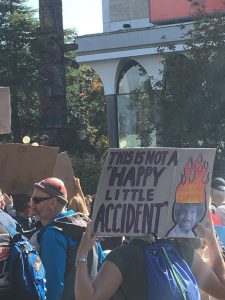 ote on Loss and Educating Climate Deniers
ote on Loss and Educating Climate Deniers
I take climate change very seriously. As inspiring and exciting as this issue was, it also came with some sadness. I made the decision to un-friend a friend of over 10 years because of their denial of climate change and decision to support the Conservative leader Andrew Scheer. While I feel great loss because of this, I just cannot understand how someone could deny climate change as it is a very real, and happening crisis. In the near future I will reach out to this friend and see if a conversation about the issue is possible. I have to go prepared, however, as the conversation will be a long one and likely heated. Has anyone else been in this, or a similar, position? How did you approach it? did you approach it?